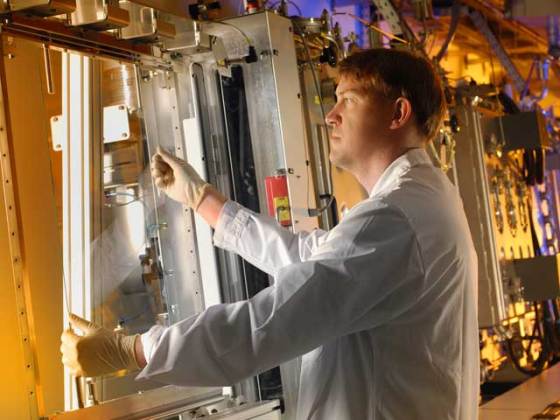Major improvement in HIT solar cells production process
 Researchers at the Fraunhofer Institute for Surface Engineering and Thin Films (Fraunhofer IST) in Braunschweig are engineering coating processes and thin film layering systems aimed to drastically lower the production costs of solar cells by reducing the amount of materials used during the production of “HIT” (Heterojunction with Intrinsic Thin layer) photovoltaic cells that can achieve efficiencies of up to 23 percent.
Researchers at the Fraunhofer Institute for Surface Engineering and Thin Films (Fraunhofer IST) in Braunschweig are engineering coating processes and thin film layering systems aimed to drastically lower the production costs of solar cells by reducing the amount of materials used during the production of “HIT” (Heterojunction with Intrinsic Thin layer) photovoltaic cells that can achieve efficiencies of up to 23 percent.
HIT cells consist of a crystalline silicon absorber with additional thin layers of silicon. Until now, manufacturers used the plasma-CVD process (short for Chemical Vapor Deposition) to apply these layers to the substrate. Plasma activates the silane gas, thus breaking apart the silicon-hydrogen bonds, thus making free silicon atoms and the silicon-hydrogen residues settle on the surface of the substrate. The problem Frauhofer IST researchers decided to solve is the fact that plasma activates only 10 to 15 percent of the expensive silane gas during the process. Instead using plasma, the researchers developed a process where they activate the gas by hot wires.
“This way, we can use almost all of the silane gas, so we actually recover 85 to 90 percent of the costly gas. This reduces the overall manufacturing costs of the layers by over 50 percent. The price of the wire that we need for this process is negligible when compared to the price of the silane”, said Dr. Lothar Schäfer, department head at Fraunhofer IST. “In this respect, our system is the only one that coats the substrate continuously during the movement – this is also referred to as an in-line process.”
The silicon film grows up at the surface about five times faster than with plasma CVD while maintaining the same quality of the layer. Currently available method allows coating of a surface which measures 50 by 60 centimeters (20 by 24 inches), but the researchers claim it can be easily scaled up to the more common industry format. The researchers see another potential use for their method during the plasma CVD coating process of the triple photovoltaic cells. The method uses rather scarce but highly efficient germanium, and the new coating process would make the cells much more cost-effective.
HIT cells suffer from another problem, and that is their contact grid of metal which conducts the resulting holes and electrons. The grid is normally formed through evaporation of ceramic tiles, made from aluminum-doped zinc or indium-zinc oxide through the sputter process. The dissolved components attach to the surface, thereby producing a thin layer. Unfortunately, the ceramic tiles are also quite expensive.
The researchers at Fraunhofer IST propose usage of use metallic tiles which are 80 percent cheaper than their ceramic counterparts. In order to maintain the desired sputter process, an electronic control is introduced to ensure that the metal tiles do not oxidize.
“Even though the control outlay is greater, we can still lower the cost of this production process by 35 percent for 1.4 square meter coatings”, said Dr. Volker Sittinger, group manager at Fraunhofer IST. “You can produce all silicon layers using the hot-wire CVD, and all transparent conductive layers through sputtering with metal tiles. In principle, these processes should also be suitable for large formats.”
The research team intends to combine both processes over the long term, in order to make thin-coated solar cells more affordable and profitable. However, the processes still needs to be perfected and Fraunhofer IST researchers claim it will take about three to five years until the process will be used in the mass production of solar cells.










author
Scientists will exhibit a few of these new processes at the EU PVSEC trade show in Frankfurt from September 25 to 28 (Hall 03, Booth G22).
Great. Researchers at the Fraunhofer Institute for Surface Engineering and Thin Films (Fraunhofer IST) in Braunschweig are doing excellent research in Solar Cells.
Dr.A.Jagadeesh Nellore(AP),India
E-mail: anumakonda.jagadeesh@gmail.com